- Home
- Articles
- Architectural Portfolio
- Architectral Presentation
- Inspirational Stories
- Architecture News
- Visualization
- BIM Industry
- Facade Design
- Parametric Design
- Career
- Landscape Architecture
- Construction
- Artificial Intelligence
- Sketching
- Design Softwares
- Diagrams
- Writing
- Architectural Tips
- Sustainability
- Courses
- Concept
- Technology
- History & Heritage
- Future of Architecture
- Guides & How-To
- Projects
- Interior Design
- Competitions
- Jobs
- Store
- Tools
- More
- Home
- Articles
- Architectural Portfolio
- Architectral Presentation
- Inspirational Stories
- Architecture News
- Visualization
- BIM Industry
- Facade Design
- Parametric Design
- Career
- Landscape Architecture
- Construction
- Artificial Intelligence
- Sketching
- Design Softwares
- Diagrams
- Writing
- Architectural Tips
- Sustainability
- Courses
- Concept
- Technology
- History & Heritage
- Future of Architecture
- Guides & How-To
- Projects
- Interior Design
- Competitions
- Jobs
- Store
- Tools
- More
Exploring Future Trends in Cultural Architecture: Sustainability, Technology, and Community Engagement
Explore the future of cultural architecture in this insightful article, examining how sustainability, technology, and community engagement are transforming design practices. Discover innovative projects worldwide that merge tradition with modernity, highlighting inclusivity and environmental consciousness.

As we step into a new era, cultural architecture is evolving in exciting ways. This transformation reflects not just our changing aesthetics but also our values, sustainability goals, and technological advancements. It’s fascinating to see how architects are blending tradition with innovation to create spaces that resonate with communities while embracing the future.
In this article, we’ll explore the key trends shaping cultural architecture. From eco-friendly materials to smart technology integration, these developments are redefining how we experience art, history, and community. Join us as we delve into the future of cultural spaces and discover how they’ll influence our lives in the years to come.

Table of Contents
ToggleOverview of Cultural Architecture
Cultural architecture serves as a mirror of society, embodying our collective values, beliefs, and identities. This field has evolved significantly, influenced by societal shifts, technological innovations, and environmental concerns. Architects now blend traditional designs with contemporary elements, fostering spaces that resonate with communities.
We see cultural architecture promoting inclusivity and accessibility, creating designs that cater to diverse audiences. Community engagement forms a core part of the design process, ensuring that the structures reflect local heritage while meeting modern needs. This approach cultivates a sense of belonging among residents.
The integration of sustainable practices marks a critical trend in cultural architecture. Eco-friendly materials, energy-efficient systems, and green spaces contribute to environmental sustainability. Architects are increasingly prioritizing designs that minimize ecological footprints while enhancing the aesthetic appeal of public spaces.
Technology plays a pivotal role in shaping cultural architecture. Smart technology integration enhances user experiences, making spaces more interactive and efficient. Features like augmented reality exhibits and sensor-driven environmental controls transform how we engage with art and culture.
As we explore these trends, we understand that cultural architecture not only preserves history but also shapes the future. This dynamic interaction between innovation and tradition creates vibrant environments that enrich our communities.
Historical Context of Cultural Architecture
Cultural architecture reflects the historical evolution of design and societal values. Its development showcases a progression from traditional forms to modern interpretations, demonstrating the impact of various cultural influences.

Evolution of Design Principles
Architectural design principles have evolved significantly over centuries. Ancient civilizations prioritized functionality and symbolism, evident in structures like Greek temples and Egyptian pyramids. In the Middle Ages, Gothic architecture emphasized verticality and light, while Renaissance design embraced symmetry and classical ideals. The 19th century introduced industrialization, leading to the use of new materials and technologies that shaped contemporary architecture. Today, principles include sustainability and community engagement, ensuring spaces resonate with cultural identity and contemporary needs.
Influence of Technology
Technology profoundly influences cultural architecture. The advent of digital design tools has transformed the creative process, allowing architects to visualize and manipulate complex forms. Building Information Modeling (BIM) enhances collaboration, enabling stakeholders to share insights seamlessly. Additionally, advancements in materials science facilitate the use of eco-friendly resources, reducing environmental impact. Smart building technology integrates automation for energy efficiency and user comfort, bridging the gap between historical context and modern innovation.
Future Trends in Cultural Architecture
We see a significant transformation in cultural architecture, primarily driven by sustainability, technology, and community collaboration. These trends ensure that future designs resonate with the needs of communities while preserving cultural heritage.

Sustainable Design Practices
Sustainable design practices dominate future trends in cultural architecture. Architects prioritize eco-friendly materials, energy-efficient systems, and waste reduction strategies to minimize environmental impact. Green roofs, solar panels, and rainwater harvesting systems become standard features. Communities benefit from local sourcing, supporting regional economies while reducing carbon footprints. The implementation of biophilic design principles enhances natural light and air quality, promoting well-being and connection to nature.
Integration of Technology
Integration of technology is reshaping cultural architecture. Smart building systems improve energy management and user comfort, while digital tools streamline the design process. Building Information Modeling (BIM) enhances collaboration between architects, engineers, and stakeholders, facilitating efficiency and innovation. Virtual and augmented reality allow clients to experience designs before construction, ensuring alignment with community values. Intelligent systems adapt spaces for various uses, making them multifunctional and responsive.
Emphasis on Community Engagement
Emphasis on community engagement transforms the architectural design process. We encourage active participation from local residents to ensure structures reflect cultural identities and meet contemporary needs. Interactive workshops, design charrettes, and public forums create a sense of ownership among community members. By incorporating feedback, architects create spaces that resonate with local heritage while fostering inclusivity and accessibility. This collaborative approach strengthens social ties and promotes a sense of belonging.
Case Studies of Innovative Projects
We explore a selection of innovative projects in cultural architecture that exemplify current trends and successful approaches worldwide.

Examples from Around the World
- The Elbphilharmonie, Germany: This concert hall in Hamburg merges a historic warehouse with a contemporary glass structure. The project highlights community engagement, while its design symbolizes unity through music.
- The Interlace, Singapore: This residential complex uses a unique stacking approach, promoting social interaction among dwellers. Green spaces integrate with the design, enhancing sustainability and community well-being.
- Cultural Center of the Philippines, Manila: This center showcases Filipino culture through its dynamic spaces and sustainable practices. The design reflects local heritage while providing inclusive access to diverse cultural programs.
- Museum of the Future, Dubai: This museum features a futuristic design accentuated by advanced technology. Its architecture invites public interaction, emphasizing innovation and community learning.
Lessons Learned from Successful Designs
- Emphasizing Community Participation: Successful projects prioritize input from local communities, ensuring designs resonate with cultural identity and meet societal needs.
- Integrating Sustainability: Effective cultural architecture incorporates eco-friendly materials and energy-efficient systems, reducing the environmental impact while enhancing aesthetic appeal.
- Leveraging Technology: Innovative designs utilize smart technology to enhance visitor experiences. Interactive features and digital tools facilitate engagement and education within cultural spaces.
- Promoting Inclusivity: Successful projects address accessibility, creating welcoming environments that cater to diverse populations. This approach fosters connection and enhances overall community vibrancy.
The Role of Cultural Identity in Architecture
Cultural identity profoundly influences architectural design, shaping how spaces reflect collective values and traditions while remaining responsive to modern needs. As we explore cultural identity, two key aspects emerge: balancing modernity and tradition, and representing diverse communities.

Balancing Modernity and Tradition
Architects navigate the delicate interplay between contemporary design elements and traditional architectural styles. We see structures that prioritize modern functionality while incorporating historical motifs, ensuring that the essence of local heritage remains intact. Buildings such as the Elbphilharmonie in Germany exemplify this balance, showcasing cutting-edge design alongside elements that pay homage to the site’s maritime history. Through thoughtful integration of traditional features within modern frameworks, architects create spaces that resonate with both current and historical cultural identities.
Representation of Diverse Communities
Architectural projects increasingly emphasize inclusivity, reflecting the diverse backgrounds within communities. We recognize how design can cultivate cultural representation by integrating symbolic elements that honor unique local identities. The Cultural Center of the Philippines serves as a key example, celebrating Filipino heritage while providing accessible environments that welcome all. By actively involving community members in the design process, architects can ensure that structures embody the voices and values of the diverse populations they serve, fostering a stronger sense of belonging and connection.
Conclusion
Cultural architecture continuously evolves, reflecting societal changes and advancements. Sustainability drives design, as architects integrate eco-friendly materials and energy-efficient systems into projects. Smart building technology ensures user comfort while minimizing environmental impact.
Community engagement remains vital, as local participation shapes designs that resonate with cultural identities. We see successful projects demonstrate this approach, ensuring structures promote inclusivity and access for diverse populations. Notable examples, such as the Elbphilharmonie and the Cultural Center of the Philippines, showcase how architects balance tradition with modernity.
Future trends in cultural architecture underscore the importance of these elements, fostering environments that strengthen social connections and enhance community well-being. By prioritizing sustainability, technology, and community involvement, we contribute to vibrant, culturally-rich spaces that reflect our collective values and identities.
- architecture and technology
- architecture for communities
- climate-responsive design
- community-focused design
- cultural architecture innovation
- cultural heritage design
- cultural identity in design
- cultural sustainability
- digital integration in architecture
- eco-friendly design strategies
- environmentally friendly architecture
- future cultural spaces
- future trends in cultural architecture
- Green Architecture
- interactive cultural spaces
- modern cultural architecture
- public engagement in architecture
- smart cultural spaces
- sustainable cultural buildings
- Technology in Architecture
Submit your architectural projects
Follow these steps for submission your project. Submission FormLatest Posts
What Really Keeps a City Alive? The Energy Behind Urban Motion
What gives a city its sense of life, the constant hum that...
The Vertical Revolution: How Basement Underpinning Creates Architectural Gold from Forgotten Spaces
Think about the last time you walked into a room with soaring...
Best Tools for Tracking Construction Labor Hours
Quick View of the Products Listed Best Overall: Workyard – Complete construction...
More Than a Gate: Designing a Secure and Stylish Home Entryway
A property’s entrance tells a story before a single guest steps inside....












Leave a comment